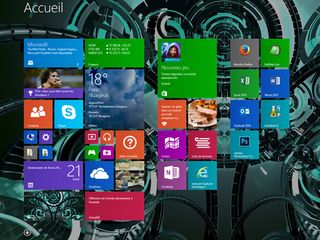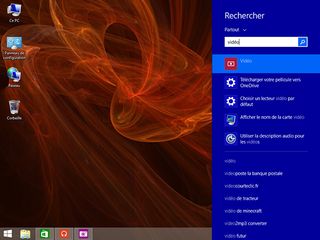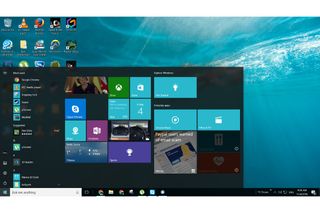History Of Microsoft Windows
Windows 8 (2012)

With its dominance on the desktop secure, Microsoft began to push into other OS markets. It released a number of lightweight Windows-based OSes for mobile devices, and it later created Windows 8 to target both desktops and mobile devices. Windows 8 used a new UI that did away with the Start bar first introduced on Windows 95. Instead, the start screen on Windows 8 used a series of tiles.
When you launched most Windows programs in Windows 8, they opened in full-screen mode. This was somewhat surprising, as it was the first Windows OS to force programs to launch in full-screen mode since Windows 3.1. Although such a feature is desirable on a tablet, for example, it was poorly received on desktop PCs. It proved especially bothersome for multitasking. Windows 8 did manage to succeed in gaining a following among some users that found its tablet-inspired interface useful, but it was unable to surpass its predecessors in sales.
MORE: 23 Years of Supercomputer Evolution
MORE: History Of Mechanical Keyboards
Windows 8.1 (2013)

Microsoft released Windows 8.1 just one year after Windows 8; it was offered as a free upgrade to users with Windows 8. Windows 8.1 was nearly identical to Windows 8, but with a few changes that users had demanded. Microsoft returned the Start button to the desktop, and it also had the option to boot directly to the desktop instead of the start screen. These changes pleased users accustomed to the machinations of older versions of Windows. Even so, Windows 8.1 was unable to overtake Windows 7 in the OS market.
MORE: The History of Intel CPUs
MORE: The History of AMD CPUs
Stay on the Cutting Edge
Join the experts who read Tom's Hardware for the inside track on enthusiast PC tech news — and have for over 25 years. We'll send breaking news and in-depth reviews of CPUs, GPUs, AI, maker hardware and more straight to your inbox.
Windows 10 (2015)

Windows 10 is Microsoft's most recent OS, with a wide range of improvements over its predecessor. Microsoft returned to a more traditional UI centered around a desktop view with a Start bar at the bottom of the screen. You can see some aspects of Windows 8/8.1 in Windows 10, such as the live tiles in the start menu, but Microsoft added numerous new features to Windows 10, as well. Cortana, Microsoft's digital assistant, is built into the OS and can perform a number of functions by voice command, and Microsoft redesigned many of its applications in Windows 10 for Cortana compatibility. The OS also launched with a new web browser called Microsoft Edge, which is designed to be faster and easier to use than the older Internet Explorer browser.
There have been a few criticisms leveraged against Windows 10 in regards to user privacy and the amount of information gathered by Microsoft from the OS, but otherwise it has thus far been well received.
MORE: Best Deals
MORE: Hot Bargains @PurchDeals
-
nine9fingers You have to remember, Gates added nothing to PC-dos, Dos or Windows, all he was ever interested was collecting a penny from each USERReply -
shrapnel_indie Although you don't hear about it anymore, rumors existed of Bill Gates dumpster diving to get his BASIC code. It was also Microsoft's partnership with OEMs that ensured no other OS had a shot of becoming popular. MS had legal issues that appeared later for the practice as it forced OEMs who wanted to use MS Operating Systems into exclusivity.Reply
WARNING: Conspiracy theory found within comment.
I also still think the history between OS/2 and Windows NT is sketchy. Look at some of the naming conventions between parts (i.e. OS/2: HPFS, WinNT:NTFS), which I see is mentioned when talking about NT3.1. Also, look at how OS/2 didn't actually make major and needed improvements until after Microsoft ended the partnership between IBM and themselves. IMHO, MS was, despite what they told IBM, working on their OS/2 killer from day 1 (mostly planning, and learning at the earliest of stages.) Using the knowledge of IBM to learn and build from from the early stages, while making sure OS/2 wasn't good enough too compete when the time came. -
bit_user Too bad OS/2 got killed off. I knew some folks who really liked it.Reply
Also, please review ReactOS (http://reactos.org).
A couple points:
■ Windows for Workgroups 3.11 was a pretty major release, as I think it was first to integrate a TCP/IP stack. I had a friend who seemed unreasonably enthusiastic about it (he had a home network).
■ Windows NT introduced NTFS. Pretty obvious, but still... a big development. It also shipped with OpenGL support, as MS was intending to compete in the workstation segment. Fun fact: Michael Abrash optimized the NTFS code at MS, before joining ID Software to work on Quake. He's now Chief Scientist at Oculus/Facebook. He literally wrote the book on code optimization (The Zen of Code Optimization).
■Windows 95 ... System stability was significantly increased by running multiple virtual machines under the OS.
I'm no Windows architecture guru, but I think it's misleading to say it used VMs. These certainly weren't VMs in the way we now understand them. I think they were simply protected memory segments, with DOS boxes replicating the state of a DOS emulation layer. Also, Windows 3.1 (and possibly before) already used Protected Mode (anyone remember General Protection Faults?). Maybe Win95 made this compulsory?
■ Cool thing about Win95 is that programs always ran in 32-bit mode. So, you didn't need to do anything special to have up to 4 GB of flat address space in a single program. As a programmer, I considered this feature (as well as the promise of Direct 3D, which got dropped from the initial release) the most exciting development. Prior to that, it was annoying just to go beyond 64k (due to x86's 20-bit segmented addressing scheme).
■ Win95 bundled Internet Explorer, which was the main source of their anti-trust litigation. It looked like MS might've gotten split up, but George W. Bush put an end to the matter, when he took office.
■ I'm pretty sure WinNT 4.0 had a version of Direct 3D released for it. Win2k shipped with Direct 3D support.
■ I never ran WinME, but I think it was the last to ship without NTFS support.
■ Windows 8 introduced support for cross-platform apps that could be run on both ARM-based WinRT tablets/phones and x86_64 desktop PCs.
■ Not only does Windows 10 have embedded spy-ware, but it also integrates Windows Store.
Me: DOS 5.0 -> DOS 6.22 -> Win3.1 -> (briefly Win95) -> WinNT 4 Server -> Win2k Server -> WinXP Pro -> Win7 Pro
And I first booted Linux in 1991. -
synphul I ran most of these at one point in time. Before switching to xp I was happy to get rid of win9x and replace it with win2k, the nt based os's were a lot more stable and seemed to have better memory management.Reply
I think it's why xp was so successful, prior to xp there was a sort of division between home and business operating systems. The home varieties still being dos based with the business versions like win2k being nt based. Most things ran well on win2k but they didn't have quite the expansive program/driver support that the dos based had.
When xp rolled out it merged the best of both worlds, the stability of the nt kernel, improved memory management and the broader driver/app support of the 'home' flavors. Likely one of the best single moves MS made in their history of the windows os. -
Martell1977 What about Windows 3.11 for Workgroups? That was my first Windows operating system. I had DOS 6.22 with it, which is where I spent most of my time.Reply
Also, I was surprised there was no mention of when MS partnered (with no contract) with Apple and took the GUI/mouse interface, which ironically they got from Xerox.
Lastly, when did NTFS get introduced? And I was surprised there was no mention of how Windows XP was able to install/run on FAT32 or NTFS, but on NTFS it seemed more stable and ran faster. IIRC, Windows XP was the last Windows OS to use FAT32.
I remember someone telling me that Windows 98 got it's name from the fact that you had to reinstall it every 98 days as it degraded so fast...LMAO! -
bit_user Reply
There was an infamous bug in Win95 or Win98, where the machine would crash every 28 days when some timer overflowed.18858540 said:I remember someone telling me that Windows 98 got it's name from the fact that you had to reinstall it every 98 days as it degraded so fast...LMAO!
I think Win98 had some sort of background optimizer that ran defrag and maybe something else. I seem to recall it got a lot of bad press, at least until SE. I never ran either, as I was already on NT 4 Server, with a quad-CPU machine! -
Tom Griffin Seems to be missing Windows/286, Windows/386 and Windows NT 3.5x. Fun days using Microsoft Macro Assembler to access the Windows API.Reply -
turkey3_scratch I vaguely remember when I was like 3 years old on the Windows 2000 machine playing some Teletubbies game on the Internet. That old machine is still in the basement, I should open it up. I don't think it works anymore.Reply
Most Popular


